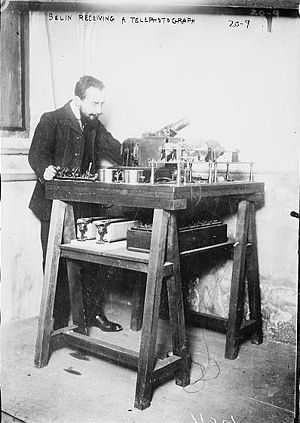Wirephoto
| Wirephoto | |
|---|---|
 Belinograph BEP2V wirephoto machine by Edouard Bélin, 1930 | |
| Process type |
Physical Analogue |
| Industrial sector(s) |
Wire Service Photojournalism |
| Main technologies or sub-processes |
Telegraph Telephone Photography |
| Product(s) | Telefaxed photographs |
| Leading companies |
Western Union AT&T Associated Press etc. |
| Year of invention | 1920s |

Wirephoto or telephotography is the sending of pictures by telegraph or telephone.
Western Union transmitted its first halftone photograph in 1921. AT&T followed in 1924,[1] and RCA sent a Radiophoto in 1926. The Associated Press began its Wirephoto service in 1935, and held a trademark on the term AP Wirephoto between 1963 and 2004. The first AP photo sent by wire depicted the crash of a small plane in New York's Adirondack Mountains.[2]
Technologically and commercially, the wirephoto was the successor to Ernest A. Hummel's Telediagraph of 1895, which had transmitted electrically scanned schellac-on-foil originals over a dedicated circuit connecting the New York Herald and the Chicago Times Herald, the St. Louis Republic, the Boston Herald, and the Philadelphia Inquirer.[3][4]
Édouard Belin's Belinograph of 1913, which scanned using a photocell and transmitted over ordinary phone lines, formed the basis for the AT&T Wirephoto service. In Europe, services similar to a wirephoto were called a Belino.
The first wirephoto systems were slow and did not reproduce well. In 1929, Dr. Vladimir Zworykin, an electronic engineer working for Western Electric, came up with a system that produced a better reproduction and could transmit a full page in approximately one minute.[5]
In the 1930s, wirephoto machines of any reasonable speed were very large and expensive and required a dedicated phone line. News media firms like the Associated Press, used expensive leased telephone lines to transmit wirephotos. In the mid-1930s a technology battle began for less expensive portable wirephoto equipment that could transmit photos over standard phone lines. A prototype device in the experimental stage was available in San Francisco when the large Navy air ship Macon crashed in the Pacific off of the coast of California. A photo was taken and transmitted to New York over regular phone lines. Later a totally portable wirephoto copier and transmitter was put into use by International News Photos, which could be carried anywhere and needed only a standard long distance phone line.[6]
Notes and references
- ↑ "1924: Fax Service". AT&T Labs timeline. Retrieved 2010-06-30.
- ↑ "AP History 1901-1950: The Modern Cooperative Grows". Associated Press. Retrieved 2010-06-30.
- ↑ Cook, Charles Emerson (April 1900). "Pictures by Telegraph (HTML transcription)". Pearson's Magazine. Retrieved 2010-06-30.
- ↑ "From Pearson's Magazine, April 1900 Pictures by Telegraph". Retrieved 2010-06-30.
- ↑ "Photo Letters Sent in a Minute by Radio". Popular Science: 62. September 1929. Retrieved 2012-04-28.
- ↑ Schnurmacher, Emile C (July 1937). "Wire That Photo". Popular Mechanics: 392–395, 128A–133A. Retrieved 2012-04-28.
See also
| Wikimedia Commons has media related to Telephotography. |